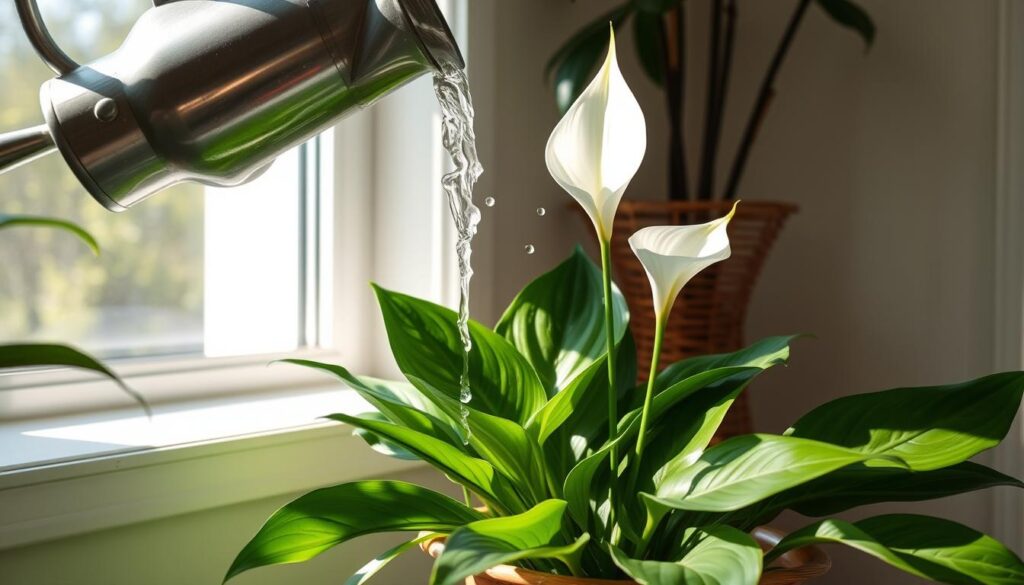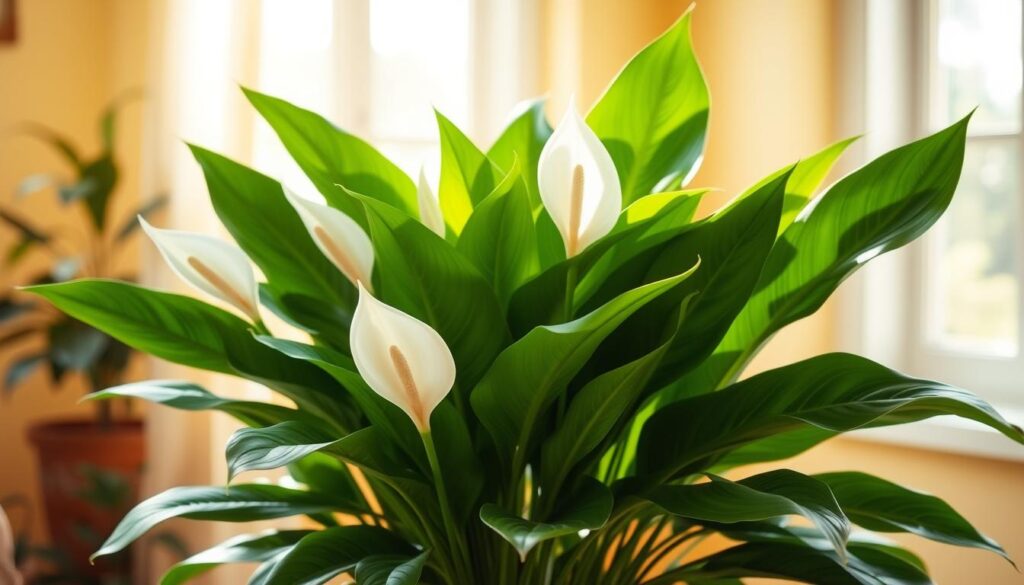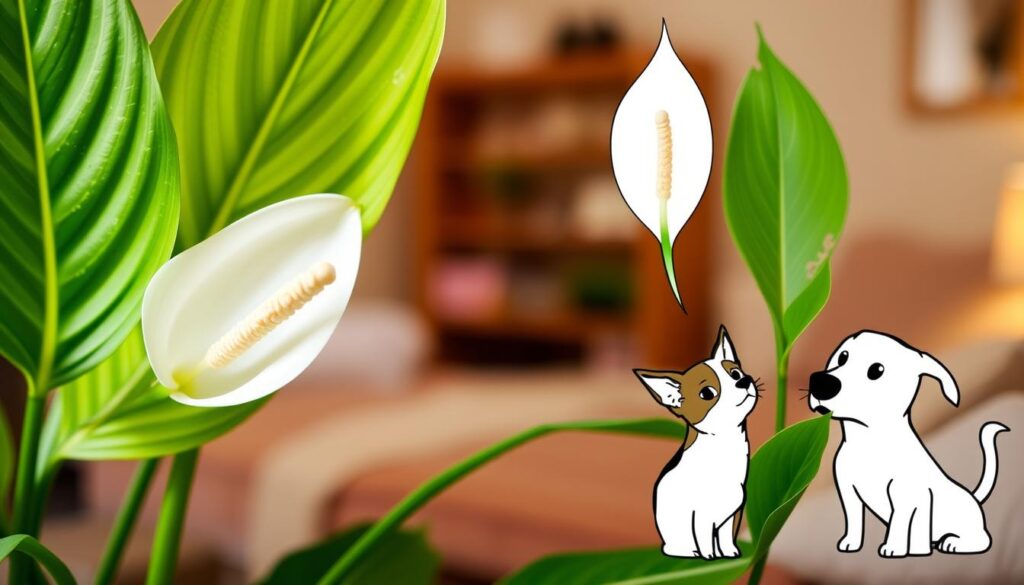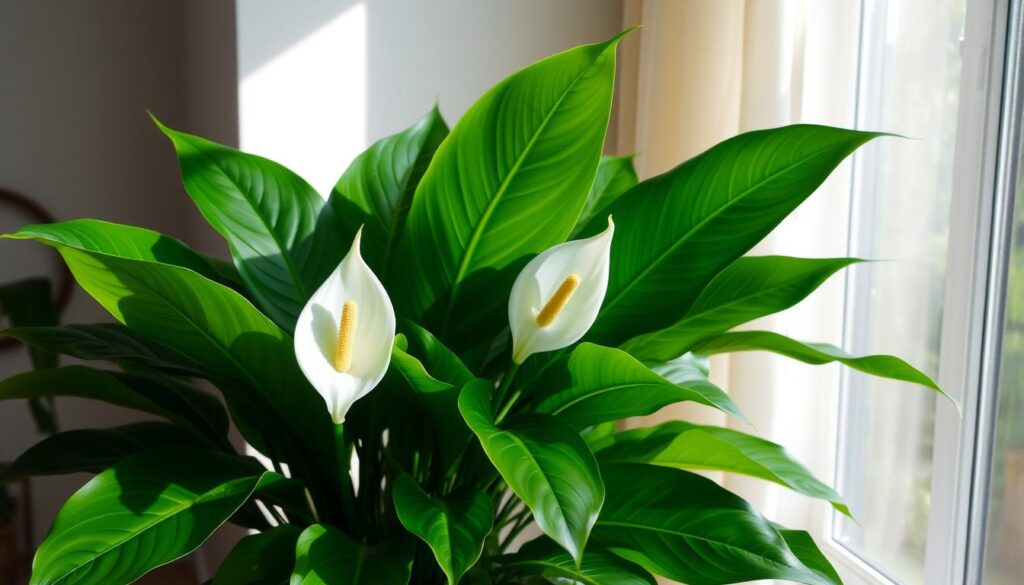Are you drawn to the peace lily’s white blooms and green leaves? This tropical plant, known as Spathiphyllum, is a favorite for indoor spaces. But how do you keep your peace lily thriving? In this guide, we’ll share the essential tips for caring for a peace lily and making it a lively, easy-to-care-for part of your home or office.
Key Takeaways
- Peace lilies do best in bright, indirect light and moist soil.
- Right watering and fertilizing are key for growth and blooms.
- Repotting in spring can help with new growth.
- Fixing issues like yellow leaves and wilting can revive a peace lily.
- Peace lilies are toxic to pets and kids, so handle with care.
What is a Peace Lily?
Peace lilies, known scientifically as Spathiphyllum wallisii, are not true lilies. They are tropical, evergreen plants from the Araceae family. This family also includes philodendrons and dumb canes. Peace lilies come from the rainforests of Central and South America.
They are known for their large, glossy leaves and white, flag-like flowers. These plants grow 1 to 4 feet tall. Their white flowers, which look like flags of peace, bloom in early spring and last up to four weeks.
Origins and Characteristics
Peace lilies come from the warm, humid rainforests of Central and South America. They can grow well in many lighting conditions. This makes them easy to care for.
Their leaves can grow up to 16 inches long. This adds a lush look to any room.
| Characteristic | Description |
|---|---|
| Plant Family | Araceae |
| Native Habitat | Central and South America |
| Height | 1 to 4 feet |
| Leaf Shape | Large, lance-shaped |
| Flower | White, flag-like spathes |
| Bloom Time | Early spring |
“The peace lily’s graceful, arching leaves and pure white flowers make it a popular and striking houseplant.”
Where to Grow Peace Lilies
Peace lilies are mostly grown as indoor houseplants. They can’t handle cold weather and grow best in warm, humid places (USDA Zones 10-12). Indoors, they do well in bright, indirect light, like an east-facing window. Direct sunlight can make their leaves turn brown.
They also love high humidity. So, a bathroom or kitchen is perfect for them.
If you live in a warm outdoor climate, you can grow peace lilies outside. They need a shady, sheltered spot with moist soil. Make sure they’re protected from strong sunlight and winds.
Outdoor peace lilies need well-draining soil and regular watering. This keeps the soil damp but not too wet.
| Location | Lighting Conditions | Ideal Humidity |
|---|---|---|
| Indoors | Bright, indirect light | High (50% or more) |
| Outdoors (USDA Zones 10-12) | Partial shade, sheltered location | High (50% or more) |
Peace lilies do well indoors or outdoors, as long as it’s humid and the light is right. Knowing what they like helps them grow strong and beautiful in any space.

“Peace lilies are popular houseplants, known for their ability to grow in low light conditions.”
Planting and Repotting Peace Lilies
Potting Mix and Container Selection
Choosing the right potting mix and container size is crucial for a peace lily. Use a mix that drains well but holds moisture, like Miracle-Gro® Indoor Potting Mix. It has coconut coir to help the soil re-wet easily.
The container should be only a little bigger than the plant’s root ball. It should be no more than a third larger. This size allows for growth without causing waterlogging or root rot. Make sure the container has enough drainage holes to let out excess water.
Repotting peace lilies every 1-2 years in spring is a good idea. It gives them fresh soil and prevents them from becoming rootbound. Signs that a peace lily needs repotting include wilting, yellowing leaves, and roots coming out of the drainage holes.
“Peace lilies prefer a container that is only slightly larger than their root ball to prevent issues like excess water retention and root rot.”
When repotting, check the roots and remove any that look mushy or brown. This means they might have root rot. After repotting, water the plant carefully. Let the top layer of soil dry before watering again to avoid over-watering.
Watering Peace Lilies
Watering peace lilies right is key to their health. They like soil that’s moist but not too wet. Water when the top inch of soil feels dry. Peace lilies are sensitive to tap water, so filtered or distilled water is better.
When peace lilies need water, their leaves start to droop. Too much water can turn leaves yellow and cause root rot. Not enough water makes leaves wilt. It’s all about finding the right balance.
| Watering Recommendations | Signs of Over/Underwatering |
|---|---|
|
|
By following these tips, your peace lily will stay healthy and bright for years.

“The key to keeping a peace lily happy and healthy is consistent, balanced watering. Pay attention to the soil and leaves, and you’ll have a thriving plant for a long time.”
Feeding and Fertilizing
Peace lilies don’t need a lot of food, but they do benefit from some fertilization. This is especially true when they’re growing fast. Use a balanced, water-soluble fertilizer for indoor plants every 6-8 weeks in spring and summer.
Providing the Right Nutrients
For the best fertilizer for peace lilies, choose one with more phosphorus. This helps them bloom well. But, don’t overdo it. Too much fertilizer can cause weak, green flowers or even burn the leaves. The right nutrients are key to keeping your peace lily healthy and blooming.
| Fertilizer Type | Application Frequency |
|---|---|
| Liquid Fertilizer | Every 4-6 weeks during growing season |
| Slow-Release Pellets | Early spring and early summer |
| Plant Food Spikes | Every 30-60 days during growing season |
Always apply fertilizer to moist soil for best absorption. But, don’t overdo it. Too much can harm your plant. If you see signs of too much fertilizer, like brown tips or yellow leaves, stop feeding until next year.
“Providing the right nutrients through proper fertilization can help keep peace lilies lush and encourage vibrant flower production.”
https://www.youtube.com/watch?v=Gr-EiOz8AYk
Caring for a Peace Lily
Maintaining a thriving peace lily is more than just watering and fertilizing. To keep these plants healthy and vibrant, consider these tips:
- Regularly wipe down the large leaves to remove dust and improve photosynthesis.
- Deadhead spent flowers to encourage more blooms.
- Peace lilies like high humidity. Mist the leaves or use a pebble tray.
Watch out for pests, brown leaf tips, and yellowing leaves. Quick action can keep your plant healthy and looking good. With proper care, peace lilies can live a decade or more and grow up to 6 feet tall and wide.
“Peace lilies are versatile, low-maintenance plants that can thrive in a variety of indoor environments.”
By following these peace lily care tips and watching your plant’s needs, you can enjoy its air-purifying benefits and beautiful blooms for years.

Peace lilies prefer to stay lightly moist. Check the soil before watering to avoid soggy roots. They like average indoor temperatures between 65 to 85 degrees and can be fertilized every 6-8 weeks during the growing season. With the right peace lily maintenance, your plant will stay healthy and keep your air clean.
Reviving a Dying Peace Lily
If your peace lily looks droopy, don’t worry. These plants can bounce back with the right care. The first step is to find out what’s wrong.
Start by checking the soil moisture. If it’s dry, water well and wait for it to perk up. But if it’s too wet, let it dry a bit before watering again. Adjusting the light and humidity can also help.
Next, trim off any damaged or dead leaves. This helps the plant look better and focus on growing new leaves. With TLC, a dying peace lily can quickly regain its health.
To help it recover, add a balanced plant fertilizer to the soil. This gives the plant the nutrients it needs. Also, check the roots for any signs of rot, as this can cause wilting.
By following these steps, you can bring your peace lily back to life. With patience and the right care, these plants can overcome even the toughest challenges.
Key Tips for Reviving a Wilted Peace Lily
- Check soil moisture and adjust watering as needed
- Provide bright, indirect light and increase humidity levels
- Trim off any damaged or dead leaves
- Add a balanced fertilizer to enrich the soil
- Inspect the roots for signs of rot and trim off any damaged parts
| Symptom | Potential Cause | Solution |
|---|---|---|
| Wilted or drooping leaves | Under or overwatering | Check soil moisture and adjust watering accordingly |
| Yellowing leaves | Excessively dry or wet soil, or too much direct sunlight | Adjust light and watering, move to a more suitable location |
| Brown leaf tips | Extremes in moisture or excessive fertilizer salts | Maintain consistent soil moisture and reduce fertilizer use |
“With a little patience and the right care, peace lilies can often recover from even the most dire-looking situations.”
Peace Lily Toxicity Concerns
Peace lilies are loved for their green leaves and white flowers. But, they can be harmful to pets and kids because they are toxic. They have a compound called calcium oxalate that can cause irritation and swelling if eaten.
For pet owners and families with young kids, peace lilies are a concern. All parts of the plant, including leaves and flowers, are mildly toxic. Eating the plant can lead to stomach or breathing problems, causing mouth pain, nausea, and vomiting.
Even though peace lilies are not extremely toxic, it’s important to be careful. Keep these plants away from pets and children. Watching over kids and pets around peace lilies is a good idea to avoid accidents and health problems.
| Potential Symptoms of Peace Lily Toxicity | Recommended Actions |
|---|---|
|
|
Knowing about peace lily toxicity helps keep your home safe. By placing plants wisely and handling them carefully, you can enjoy their beauty without risking your family’s health.

Troubleshooting Common Peace Lily Problems
Peace lilies are known for being easy to care for. But, they can still face some common issues. Knowing how to fix these problems can help your peace lily stay healthy.
Addressing Issues
One common problem is yellowing leaves. This can happen if you water too much or too little. It can also be due to the leaves getting old. Brown leaf edges usually mean the plant gets too much sun.
Fungus gnats might show up if the soil is too wet. Letting the soil dry out a bit can help. Scale insects and mealybugs can also be a problem. You can treat them with insecticidal soap or other pest control.
If your peace lily is not doing well, find and fix the problem quickly. Keeping an eye out and acting fast will help your peace lily stay healthy.
“Proper care and attention can help resolve most common peace lily problems and keep your plant looking its best.”
By following the right steps to diagnose and fix peace lily issues, you can keep your indoor peace lily vibrant and easy to care for.
Peace Lily Light Requirements
Peace lilies can grow well in different light conditions. But, they do best in bright, indirect light. This helps them grow and bloom well. If they’re in deep shade, they might not bloom as much.
The best spot for a peace lily is an east-facing window. It gets morning sun but not too much all day. This balance helps the plant grow well without getting damaged by too much sun.
If your peace lily isn’t getting enough light, it might look unhappy. It could grow too tall, not bloom as much, or turn yellow. To fix this, move it to a brighter spot or use artificial lighting for 10-12 hours a day.
But, too much direct sunlight can hurt your peace lily. It can burn the leaves and make the colors fade. If this happens, move it to a spot with more indirect light.
It’s important to find the right balance of light for your peace lily. This keeps it healthy and encourages it to bloom regularly. Regularly rotating and cleaning the leaves also helps it absorb more light.
Providing the Ideal Lighting Conditions
- Place peace lilies in an east-facing window for bright, indirect light
- Supplement with artificial lighting (10-12 hours per day) in low-light conditions
- Avoid direct sunlight, which can damage the plant
- Rotate the plant regularly and clean leaves to maximize light absorption
By knowing what light your peace lily needs, you can make sure it thrives. It will bloom beautifully every year.

Peace Lily Soil Needs
The Right Potting Mix
Peace lilies do best in potting mixes that drain well but hold moisture. A good indoor potting mix, like Miracle-Gro® Indoor Potting Mix, is perfect. It has coconut coir to help the soil stay moist. Don’t use regular garden soil, as it’s too dense for peace lilies.
The right mix lets the roots breathe and drain excess water. This prevents root rot but keeps the plant hydrated. When you repot, choose a container with good drainage. Only go up a couple of inches in size to fit the plant’s growth.
- Peace lilies prefer best soil for peace lilies that is well-draining yet moisture-retentive.
- A high-quality peace lily potting mix containing coconut coir is an ideal choice.
- Avoid using dense garden soil, as it may not provide the necessary peace lily soil requirements for proper growth.
| Soil Characteristic | Ideal Condition for Peace Lilies |
|---|---|
| Drainage | Well-draining |
| Moisture Retention | Moisture-retentive |
| Nutrient Content | Nutrient-rich |
| Texture | Light and airy |
By giving your peace lily the right peace lily soil requirements, it will thrive indoors. You’ll get beautiful blooms and clean air.
Peace Lily Repotting Instructions
Proper repotting is key for a healthy peace lily. These plants need a new pot every 2-3 years, best in spring when they’re growing. Look for signs like wilting or roots growing out of the pot.
Choosing the right pot size is crucial. Pick one that’s just a bit wider than the current one. This keeps the peace lily snug. Carefully remove the plant from its old pot, avoiding root damage. Loosen any tangled roots, then place it in a new pot with fresh potting mix.
- Prepare a pot that is 1-2 inches wider in diameter than the current one.
- Gently remove the peace lily from its old pot, avoiding damage to the roots.
- Loosen any compacted or tangled roots before replanting.
- Fill the new pot with a high-quality, well-draining potting mix.
- Set the plant in the new pot, ensuring the root ball sits 1/2 to 1 inch below the rim.
- Water thoroughly after repotting to help the plant establish in its new home.
After repotting, keep up with regular care. But skip fertilizing for a few months to let the plant settle. Repotting gives your peace lily fresh nutrients and room to grow, keeping it healthy and vibrant.

“Repotting is an essential part of peace lily care, providing the plant with the nutrients and space it needs to thrive.”
Conclusion
Peace lilies are a great pick for those who want to bring tropical greenery indoors. They have beautiful white flowers and are easy to care for. By following the right steps, like watering and fertilizing, your peace lily will thrive for many years.
Keep an eye out for common problems and fix them quickly to keep your plant healthy. With the right care, a peace lily can be a beautiful addition to any room. It’s a low-maintenance plant that adds natural beauty to your space.
This peace lily care guide has given you all you need to know for your plant’s success. By meeting their specific needs, you’ll enjoy their lush leaves and stunning flowers. Peace lilies are a favorite among indoor gardeners for good reason.


